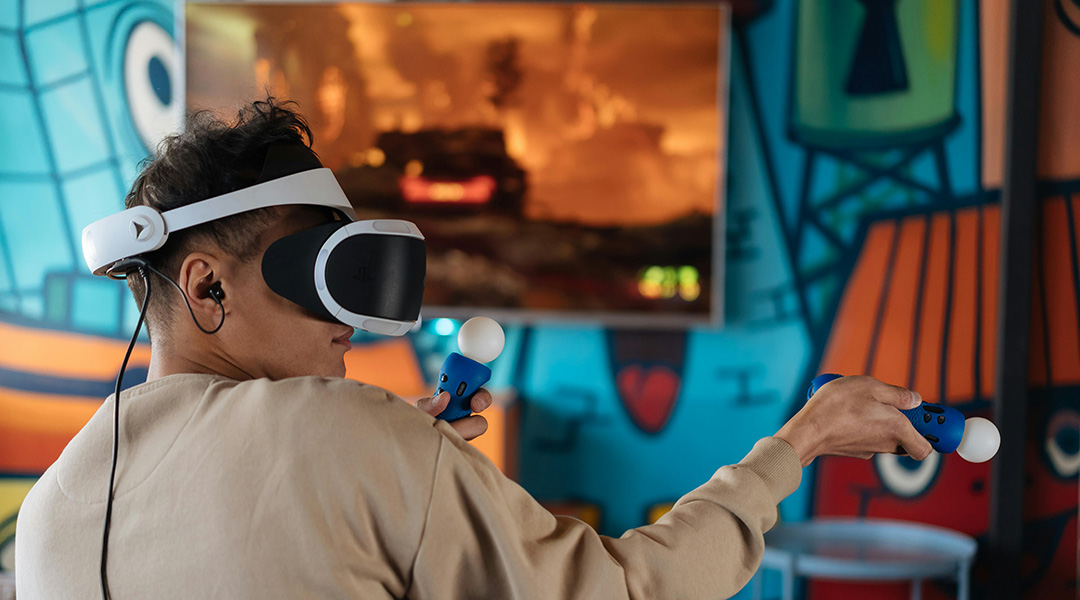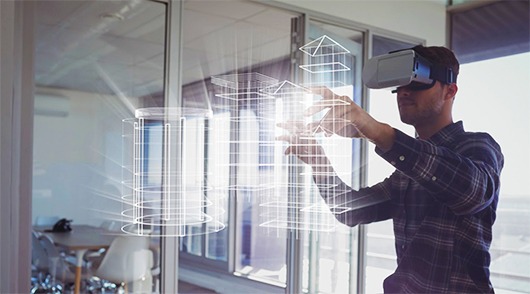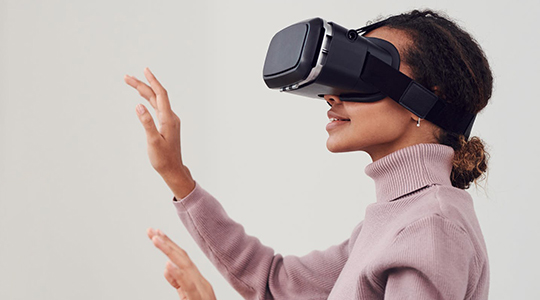Virtual reality is an artificial environment that is created with software and presented to the user in such a way that it suspends the user’s belief and he or she accepts it as a real environment via sight and sounds. VR gadgets are capable of displaying a certain picture on the screen in front of the user’s eyes, allowing him/her to look around in an artificial world, move around in areas, and interact with various objects or items, directly influencing the world of the app.
Today, this technology is widely implemented in the military, healthcare, agriculture, education, and many other realms. With the market being rather loaded with various devices like HTC Vive, Oculus Rift, PlayStation VR, and other HMDs, it becomes very accessible to a wide range of customers. Moreover, some promising devices are still yet to come, including Oculus Go and Vive Focus. As the VR-related market is rapidly growing and promising to amplify its growth, the market is projected to reach $40.4b by 2020, according to SuperData, while software sales currently are at 30% of the VR market revenue and are expected to grow up to 70% respectively. However, in spite of the fact that the device market is rather diverse, there is still a gap for groundbreaking applications for customers to get acquainted with.

Still, developing any business isn't cheap, and considering the immense potential of the market, VR applications can cost a pretty penny. However, the money won't spare anyone from difficulties as there are multiple factors that may either impede or enhance your app's development.
Here is a short list of common factors to consider before jumping into making your own VR application.
Documentation
Documentation is a vital thing when it comes to making a sophisticated application. It will not only be helpful for the developers to know the capability and the goals of the product but may also shed some light towards the main intricacies that the user experiences and how the application resolves them. Providing additional information via screenshots and showcasing past project encounters will also add to the value of a future project. Describing in steps why potential customers can improve their lives is an essential step to display that your product is worth both the money and the time spent. Getting feedback from potential customers in advance will be a priceless addition, since knowing the needs of the end-user is a universal recipe for success in every type of production.
Time Management
Time management is another essential component related to the development. Usually, the length of the development process depends on the complexity of the app. The bare minimum is usually estimated at 1 month and is increased based on the following: a number of characters and levels, a list of platforms that operate a game, a multitude of controllers, graphical fidelity, etc. However, probably one of the biggest factors regarding time management is the setting of the game.
For example, relatively simple games with a single main character who has to avoid obstacles and progress through a location, like VR Speed Blocks (exp. runners), do not require a lot of time and can be completed within a month or two.
However, if the game features multiple levels and has adventure activities, like RuneSage, it usually requires from 6 to 9 months, mostly due to designing AI patterns of behavior. Level design is also a sizeable and a time-demanding part of the development process.
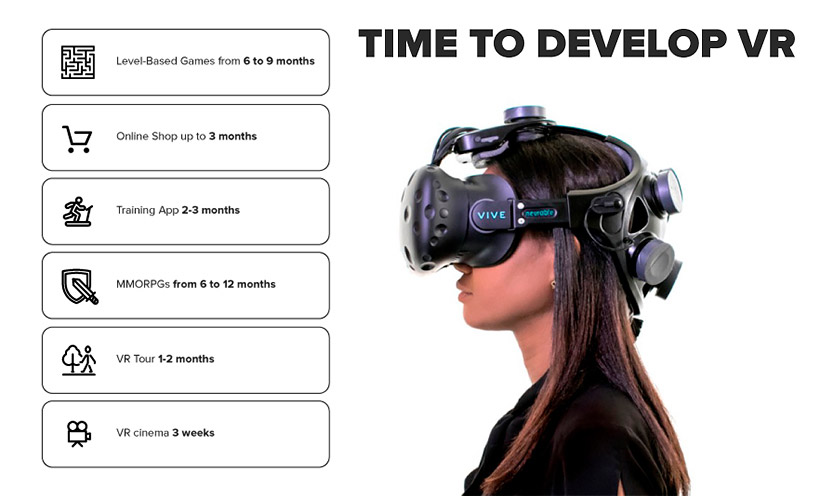
Another thing that may add to time spent is an online shop. This 3D feature becomes more and more critical to contemporary games on all platforms as this allows the publishers to monetize their game while keeping it free to download. Implementing such a feature may take up to a few months and can also be designed as a standalone project for a regular online shop in VR.
Another popular type of VR app is where you can create your own 3D assets by simply using the allocated tools. A user simply manipulates the controller and builds up any form of the desired object, like Tiny Town VR. Such projects may take up to 6 months, depending on their complexity and the initial list of tools that the user can possess.
Custom training in various types of an environment is also quite in-demand. Evacuation during a fire, military training, educational tutorials are rather simple to design, thus, it doesn't usually take more than 2-3 months to develop an app.
Meanwhile, VR MMORPGs are probably the most complex and hardest games to make. Such apps usually feature a multitude of locations for players to explore and an entire array of creatures to encounter. Furthermore, the mechanics of the main character often imply using a certain pool of abilities that also adds to the length of the development cycle. Such games often take 6-12 months to develop and release.
VR tours apps can come in handy when you need to introduce users to virtual trips and excursions through various buildings while also allowing for modifying certain objects inside of them. The customers will be able to walk through the city streets or hotel rooms, deciding whether or not they should attend these places beforehand, which may serve as a solid marketing tool towards the end-user. Applications like VR Hotel may take around 1-2 month to produce, depending on its complexity.
VR cinemas are also available for development, presenting filmmaking to the new media of virtual reality. This product allows for achieving greater immersion by making a user experience the movie at its full glory and up to a 360-degree field of view. Such applications are not particularly complex and take up to 3 weeks develop.
Price Range
Another vital thing to keep in mind is the money. Meanwhile, a time period, required for the game’s development, is similar to the executors throughout the globe; the money question, on the other hand, is rather distinctive, depending on which region they represent.
The two most expensive regions by a huge margin are North America and Western Europe. Developers from these countries charge from $40 to $240 per hour during the game production process, depending on the app’s complexity. Due to a high payment price, these two regions tend to come with a solid quality and reliability level.
Eastern European countries offer a much lower pricing varying from $25 to $75 per hour, providing a relatively solid level of product quality. Ukrainian companies are commonly considered the best in a price/quality ratio as the local companies have occupied a narrow niche of charging from $25 to $50 and providing customers with a decent service level.
India, on the other hand, offers the most moderate price list and is a good choice when the budget is very strict. Demanding from $5 to $50 per hour, companies from this region can offer a sizeable basis of raw technical skills; however, translation and design duties are not the areas where Indian companies excel. Reliability of this region isn't something to be admired as you're not insured from intricacies when dealing with its representatives.
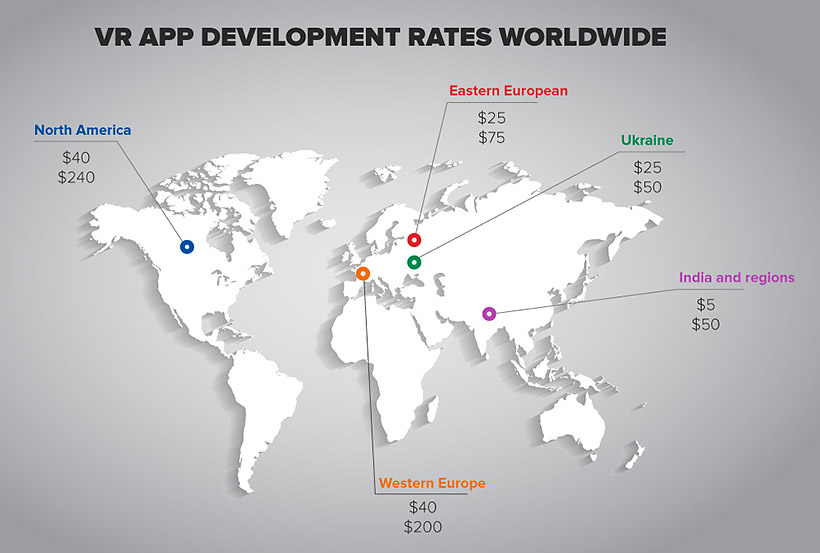
The price also depends on the development method, which implies the two most common techniques: fixed price (or time) and material.
The first option speaks for itself—basically, meaning that you want the development company to make a certain type of product for a strict period of time with a limited budget. This method is somewhat rational towards expenses, and it also allows customers to plan for the future publishing timeline. Accordingly, technical documentation and a list of requirements become even more vital with this method.
On the other hand, if you choose the time and material method, this allows for making a product with the highest quality. While having to pay for each hour of the development cycle, the customer is able to modify the requirements and features of an app throughout the mid-process, keeping it contemporary by adding or removing certain features. Moreover, this method often implies having a maximum price that sets an upper limit that may be charged, and the owner can also pay a lesser amount if the project has been completed faster than expected. All things considered, the time and material method is the most commonly used way to conduct app development as the project requirements tend to change over the course of a project.
Project Managing
Allocating a right candidate for a project manager (PM) position is an extremely important aspect of the development cycle as this person will be responsible for setting up the staff and managing a whole working process. As a rule, the PM's job is usually divided into four key duties:
- Planning
Planning is a necessary part of the project manager's job. Determining the goals, executors, and defining the timeline are the essential duties of a contemporary PM. Every project should consist of defining the project scope, its plan and schedule, and policies to maintain the achievement of certain objectives.
Planning is a necessary part of the project manager's job. Determining the goals, executors, and defining the timeline are the essential duties of a contemporary PM. Every project should consist of defining the project scope, its plan and schedule, and policies to maintain the achievement of certain objectives.
The organizing process is supposed to form a team's structure based on specialists the company currently possesses. This essentially means that a PM can decide which employees should take positions in an upcoming project. Another important aspect is to decide whether external companies' resources should be attracted or not.
- Leading
Leading is the bread and butter of experienced PMs as it mostly relies on "soft skills" like communication, motivation, and being able to resolve situations involving conflict. This aspect is also rather important since, in some cases achieving a goal is even more dependent on teamwork and not on the technical background.
- Controlling is all about tracking the project and maintaining its smooth flow. This aspect is based on three steps:
- Measuring the current state of the project;
- Evaluating the project's deviation from the plan and its reasons;
- Correcting the situation by addressing the deviation.
In other words, choosing the right person for a PM position, having regular meetings between him/her and the project staff, and defining the correct primary goals may prevent issues from occurring in the first place.
Post-Release Support
Post-release support is a nice addition to a complete product when an application is maintained or further developed by a team that produced it. The cost and time period can vary, depending on the product and the company with whom you are cooperating.
For example, some companies offer a specific warranty period that contains free-of-charge services in the event that some bugs emerge or a malfunction occurs. Adding new features or redesigning the old ones doesn't count as a warranty case and should be paid according to the existing rates.
Conclusion
VR app development is a complex process, and like any other high potential investment, it isn’t spared from possible intricacies.
All things considered, companies that manage to elaborate a well-rounded plan for their app development can benefit from an immense future growth of the VR market as it is projected to grant hefty revenues for all stakeholders involved.

